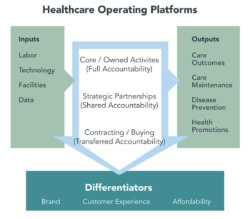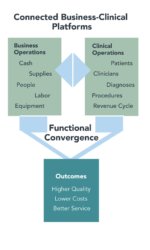July 15, 2020

Making Healthcare Better: Connected Business-Clinical Platforms Save Lives and Money
Founded in 1865, the German company BASF grew to become the world’s largest chemical manufacturer. By the early 1990s, BASF was a household name in Europe and Asia, but was relatively unknown North America.
To increase its visibility, BASF launched a slick brand awareness campaign in 1990. Its legendary “Make Things Better” ads made BASF a household name in the U.S. and Canada. This success occurred even though the low-budget campaign ran ads primarily on cable news shows.
The ad’s tagline was long but catchy: “We don’t make a lot of the products you buy. We make a lot of the products you buy better.” A typical ad from this campaign had the following cadence:
At BASF,
We don’t make the water cooler; we make it cooler.
We don’t make the jeans; we make them bluer.
We don’t make the toys; we make them tougher.
We don’t make the water scooters; we make them lighter.
At BASF,
We don’t make a lot of the products you buy.
We make a lot of the products you buy better.
Decades later, BASF’s “Make Things Better” tagline still ranks among the most recognized corporate slogans. Effective taglines have their basis in truth. In the same way BASF chemicals make products better, integrated business platforms can make healthcare delivery better.
Health systems’ mission is delivering great treatment outcomes consistently. In pursuit of that mission, they have upgraded their clinical operations with expansive surgical suites, equipped them with state-of-the-art medical devices, and orchestrate treatments with advanced electronic health records (EHRs).
Unfortunately, their gleaming exteriors mask glaring deficiencies in the application of business services to healthcare delivery. Fragmented business practices make healthcare delivery more wasteful, expensive, burdensome and depersonalized.
To manage the business of healthcare, health systems rely on antiquated legacy approaches to conduct enterprise resource planning (ERP). As a consequence, they apply suboptimal point solutions for planning, purchasing, inventory control, sales, marketing, finance, human resources and other vital ERP functions.
While health systems’ clinical operations shine, their business engines sputter. Failure to integrate ERP holistically within itself and clinical services contributes to healthcare’s subpar outcomes, inefficiency, high costs and poor customer service. There is a better way.
Balanced Clinical-Business Ecosystems

In nature and business, ideal ecosystems are balanced, symbiotic, codependent, evolutionary and self sustaining. All parts work together for the benefit of the whole. The convergence of clinical and business operations within integrated enterprise-wide management systems enhances performance and creates competitive advantage by doing the following.
- Driving better outcomes at lower costs with great customer engagement
- Optimizing human and technical capabilities
- Enhancing employee satisfaction and retention
- Eliminating waste, improving resource allocation and reducing administrative burden
Next-generation clinical and business platforms integrate and optimize enterprise-wide value creation. Aligned business systems build on existing clinical investments to enhance organizational performance, accountability and sustainability. In the process, they become the trusted source of cost and support for real-time decision-making. Everything improves.
Advanced business systems do not exist in isolation. They sustain and improve clinical operations. They contribute to superior care outcomes delivered by healthier, more satisfied and capable employees.
Business functions fulfill their essential roles in harmony with one another and clinical operations. For example, accounting for true care costs requires accurate personnel, general ledger and purchasing data. Aligned clinical and business platforms are necessary for health systems to operate as true platform companies that deliver high value services to customers.
Platforming Toward Excellence
Across industries, business models are evolving to develop Amazon-like platforms that assemble digitally connected networks of capabilities designed to deliver competitively priced products and services tailored to customer needs and preferences.

Platform companies focus on outputs, not ownership and production control. Platforming’s managerial “art” comes by organizing the company’s owned, partnered and contracted activities in ways that give customers the products and services they want at competitive prices. Getting this formula right leads to market success.
Importantly, platform companies integrate their operations and business support functions seamlessly to drive better real-time decision-making, efficient resource allocation and continuous performance improvement. In this way, finance, human capital management, supply chain and other ERP functions integrate with operations to drive better outputs.
The development of platform companies will continue to evolve and expand as they create value through cloud-based data aggregation, curation and analytics. Informed, data-driven and real-time decision-making differentiates successful platform companies.
Platforming is particularly difficult for health systems because owning and/or controlling production of healthcare service delivery has been critical to their financial success under fee-for-service (FFS) payment. Historically, FFS-driven business models have generated superior cashflow and profits; however, they also create significant fragmentation in care delivery and coordination.

As healthcare payment models shift financial risk to providers, health systems must adapt and become more customer focused. Managing risk requires health systems to deliver consistent, convenient, holistic and cost-effective care services. To thrive in customer-oriented markets, health systems must develop platforming capabilities to deliver better healthcare services at lower prices, with exceptional service.
The future of healthcare belongs to platform companies that integrate clinical and business operations to support delivery of value-based care (i.e. better outcomes at lower prices with great customer service). Like all successful platform companies, platforming healthcare companies will run on deep, interoperable data systems, achieve the right people-technology balance, and win market share by delighting consumers.
A New ERP Paradigm
Legacy ERP systems don’t work for platforming companies. Most health systems manage critical ERP functions in silos with single-focus software programs. Finance creates the general ledger. HR does talent management. Supply chain conducts purchasing.
Most industries abandoned this rigid approach to managing business functions more than a decade ago. Siloed ERP solutions miss the synergies that emerge through cross-fertilization and functional integration.
Moreover, legacy ERP systems do not align with health system business practices. They make accurate accounting for direct costing of labor, supplies and equipment almost impossible. As a consequence, health systems must rely on third-party software solutions for key business functions, including supplemental time and attendance, facilities management and financial accounting.
It gets worse. Legacy ERP systems combine data from the general ledger and the EHR data to offer piecemeal performance measurement. These tools capture targeted activity but miss the larger opportunity to identify synergies between and across business and clinical functions.
Unfortunately, incremental improvements to siloed ERP systems are not an adequate solution. Point-based software solutions can marginally improve performance but cannot exploit the interconnectedness between ERP functions and clinical operations. Transformative performance improvement requires software solutions that can power platformed operations.
As healthcare shifts toward value-based payment methodologies, point solutions lack the ability to cross-fertilize data and functions in ways that drive better care outcomes at lower costs with great customer service. By contrast, a business operations platform improves data flow, decision-making, efficiency, responsiveness and performance.
Other industries have moved to platforming business models to create products and services tailored to customer needs. It’s time for healthcare to do the same. Business service platforms can equip health systems to manage the increasing consumerism that is emerging as technology gives customers more power over their healthcare purchasing decisions.
Even when dressed up, traditional ERP business solutions lack the transformative power to meet consumer demands for on demand, transparent, affordable, convenient and personalized healthcare services. Fortunately, a new ERP paradigm is here to help. Platformed ERP business solutions integrate with existing clinical systems to deliver revolutionary healthcare services.
Functional Convergence

So, out with tired ERP silos, and in with cohesive business platforms. ERP should be a strategic resource within health systems. By providing broad and deep business functionality that integrates with existing EHRs, health systems can create function convergence between clinical and business activities. That convergence unlocks hidden value.
Within all modern organizations, software systems strive to enhance human performance, not detract from it. Health systems are no different, yet the dominance of clinical systems often overwhelms the effectiveness of business software services. The status quo offers significant room for improvement.
Health systems have invested heavily in EHRs to drive better, more consistent treatment outcomes. Quality and outcomes are the cornerstones of the clinical operations. Engaged patients and clinicians work together to find the right diagnoses and appropriate treatments to achieve the best outcomes. At the same time, health systems must collect revenue for the treatments they provide in a timely manner to sustain operations.
At a minimum, business platforms must account for these core health system functions:
- Scheduling
- Time and attendance monitoring
- Management of enterprise facilities
- Location of enterprise people and assets
- Direct and indirect costing
Beyond this, health systems need their business platforms to complement their clinical processes to drive enterprise-wide performance improvement. This occurs by embedding functionality within business software to capture, integrate and act upon clinical data.
The opportunities for driving better outcomes through aligned clinical and business platforms are manifold. The following chart details how business platforms create functional convergence with clinical operations to enhance performance with patients and clinicians as well as in diagnoses, procedures and revenue cycle.
Patients
- Create understandable and transparent treatment boards for patients and families
- Enhance patient flow and care team communications through location-based intelligence services
- Improve patient experience by acuity-based nursing assignments
- Reduce infection spread by tracing patient, staff and equipment interactions
- Promote digital innovation and connectivity
Diagnoses
- Improve care transitions so patients receive appropriate care
- Use technology to enhance care delivery, coordination, and patient engagement
- Apply clinical and business analytics to support holistic, real-time decision-making
Revenue Cycle
- Get bills out the door faster with less paperwork
- Leverage more accurate cost data to support value-based negotiations with payers
- Automatically flow revenue information to business subledgers
- Enable easy reconciliation of bank and credit account balances
Clinicians
- Improve clinician well-being by hiring the right professionals for support functions. Enable them to feel safer doing their jobs
- Reduce turnover by leveraging science-based risk indicators. Support with continuous professional engagement
- Project extended nurse schedules, allowing rotation and self-scheduling
- Reduce non-productive time spent doing paperwork and hunting for equipment
- Improve accessibility with mobile technologies and embedded learning modules
Procedures
- Reduce equipment downtime, protect revenue, and improve patient experience
- Lower costs and improve outcomes through clinically integrated supply chains
- Incorporate multi-factorial resupply and clinical equivalence purchasing to optimize performance
and create value - Embed costing and accounting software with capacity modeling for more insightful and timely decision-making
The Good News
Health systems do not have to create these powerful and convergent capabilities in isolation. They can enlist strategic partners to augment their clinical and business platforms. This is what platform companies do. By focusing on outputs and assembling capabilities linked through interoperable data exchange, platform companies deliver better, more personalized services to healthcare consumers.
Evidence of Success: Gundersen Health System Case Study
Gundersen Health System is a highly regarded six-hospital system headquartered in LaCrosse, Wisconsin. The System is highly focused on improving its business systems as part of a broader strategy to deliver more affordable care to its customers.

Gundersen undertakes 400 knee-replacement surgeries a year. The System’s approach to lowering its costs and prices for knee replacements surgeries illustrates the power of integrating clinical operations with business services to drive efficiencies and improve quality.
Knee replacement surgeries are highly profitable. Until 2016, Gundersen’s list price exceeded $50,000 per procedure. That list price was high compared with the $34,063 average U.S. price that year. Although payers rarely pay the list price, this discrepancy prompted Gundersen’s leadership to ask why their price for knee replacement surgeries was so high.
It turned out there was no particular reason. $50,000 was an estimated price that inflated over time with 3% annual increases. Many hospitals might have left the matter there. Why kill the golden goose? Gundersen dug deeper for answers.
The Wall Street Journal chronicled the story of how Gundersen determined their actual costs for knee replacement surgeries. The effort started in 2013 and took 18 months to complete. Gundersen meticulously analyzed every aspect of knee replacement surgery, from supplies to labor to facilities, and added up all the numbers.
The total cost turned out to be $10,550 per knee. In other words, the list price of $50,000 represented a 500 percent markup on its actual costs. As Harvard economist Leemore Dafny notes, “When price isn’t tightly linked to cost, that is a sign that the market isn’t competitive.”
Gundersen also identified systematic inefficiencies in its knee replacement surgeries that increased costs and impaired quality. These included variations in physician practice patterns, device choices, discharge procedures, error and infection rates, and post-acute rehabilitation.
Gundersen saved $1,000 per replacement by using technicians instead of the surgical team to prepare the patient. It slashed its knee “cement” costs by switching to a generic brand. It saved $800 with better post-operative care by eliminating certain implants that increased infection rates and extended patient
recovery time.
Gundersen used this information to standardize and improve its protocols for knee replacement surgery from intake through surgery to discharge and recovery. These program improvements lowered costs and helped patients recover more quickly with fewer complications. Knee surgery costs for Gundersen dropped by $1,850 to $8,700, a 21% decrease.
Was the effort worthwhile? Gundersen had no pressing financial incentive to do its analysis and reduce its prices. Commenting on the lessons learned, Gundersen Health System CEO Scott Rathgaber put it bluntly, “We were inefficient. We didn’t know it.”
When Gundersen calculated the cost of a knee replacement surgery, it was practicing in-depth cost accounting. This is a rarity in healthcare. The “art” in cost accounting involves allocating direct and indirect, fixed and variable costs in accurate and systematic ways. With this knowledge, Gundersen is better positioned to compete with national providers and win business from large employers who make more discerning healthcare purchasing decisions.
As Gundersen discovered, precise cost accounting reveals paths to superior performance. It liberates and empowers managers to improve quality by reducing waste and cutting costs. It makes businesses run better. As a result, companies can offer their customers better products and services at competitive prices.
In response to COVID-19, Gundersen is accelerating its strategic investments in digital technologies. It has expanded telemedicine services dramatically. Prior to Covid, less than 5% of primary care service offerings occurred remotely. By year-end, Gundersen’s CFO Gerald Oetzel expects that percentage to be greater than 50%.
Gundersen is partnering with an AI company named Olive to enhance its revenue collection from health insurance companies. It also is exploring whether to use AI to streamline purchase orders, invoice payments and regulatory compliance. Oetzel expects to earn a 5x return on the company’s AI investments.
According to Oetzel, Gundersen’s “business and clinical operations need to work together more effectively to improve outcomes, reduce waste, engage patients and make healthcare services more affordable.” This is what platform companies do.
Conclusion: Better Is Possible Now
Now, more than ever, unaffordable care is undelivered care. It is time to stop wasteful spending and focus instead on creating value. Synchronizing business and clinical operations through integrated and connected platforms makes healthcare delivery better. Here’s how.
- They make patients happy by staffing to their treatment schedules, facilitating care continuity and reducing wait times.
- They make nurses happy by using AI to anticipate and fill vital supplies, increasing safety while saving time and money.
- They make administrators happy by applying location services to ensure the proper availability of reliable medical equipment and facilities based on staff activity, lowering costs while improving care delivery.
- They make clinicians happy by using tracing to reduce infection spread.
- They make managers happy by using behavioral science to hire the right people in the right roles, reducing turnover, increasing employee satisfaction and improving customer service.
Enlightened health systems are creating functional convergence to get the right people doing the right jobs in the right way. They support their frontline professionals by getting them the right data in the right formats in real time. The result is they deliver the right care at the right time in the right place at the right price.
Like Gundersen Health System is doing, synchronizing business and clinical functions is the essential strategy for improving care affordability and effectiveness. Platforming health systems are embracing this strategy to create competitive advantage. In the process, they are saving lives and saving money.
Health systems are driving to deliver better outcomes at lower costs with great customer service. Connected clinical and business platforms are essential for value creation. Winning health systems are relying on integrated business engines to service their clinical operations and drive continuous performance improvement.
In this way, a connected enterprise is greater than the sum of its parts. As such, business platforms don’t deliver healthcare to patients. They make healthcare delivery for patients better.





